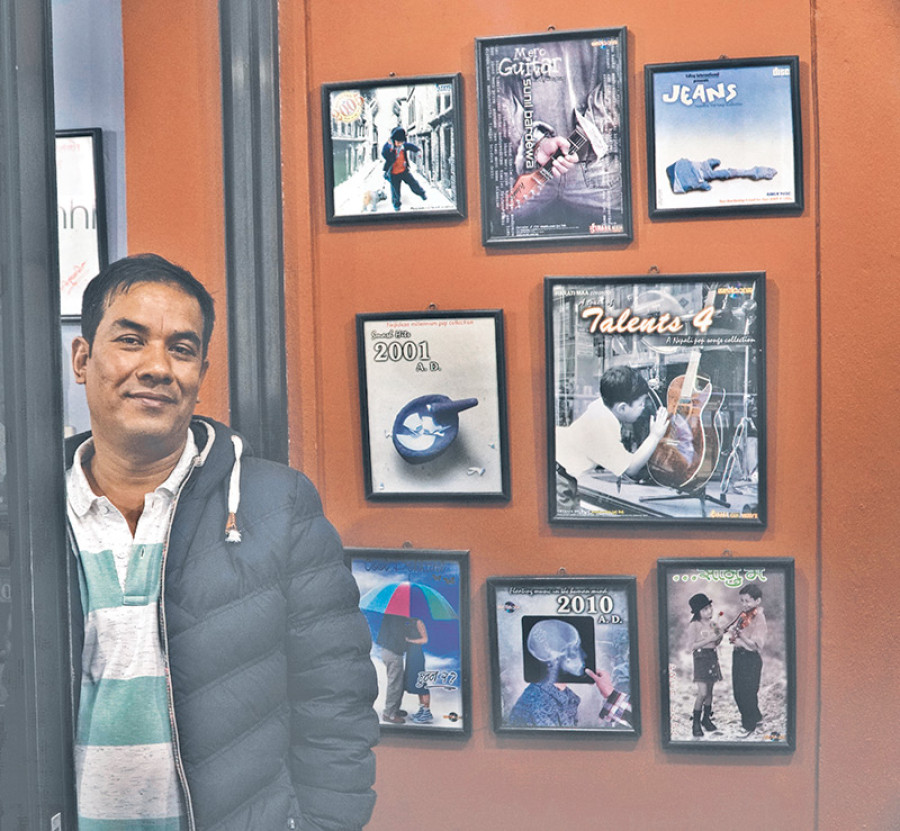Miscellaneous
The draftsman of Nepali Pop
For a Kathmandu resident who lived in the city in the 90s and the early years of the millennium, Anil Sthapit’s workspace—a modestly-sized third-floor apartment in a building opposite to Ranjana Shopping Centre’s entrance—is like a time machine.
Nhooja Tuladhar
For a Kathmandu resident who lived in the city in the 90s and the early years of the millennium, Anil Sthapit’s workspace—a modestly-sized third-floor apartment in a building opposite to Ranjana Shopping Centre’s entrance—is like a time machine. It’s not the orange paint on the walls that take you back but the prints that are hung all over them. An enlarged copy of Nima Rumba’s album Suna Suna’s cover, another one of Cobweb’s Rock ‘n’ Roll—a Mount Rushmore rendition of the band’s digitally manipulated group portrait—and another portrait, from Gloomy Guys’ Step 4 album—inspired by Queen’s The Miracle cover art—are three of more than three dozen album cover prints that cover the office walls. These album covers are a few popular ones among the 3,500 designs that Sthapit has created till date.
Although a man with many hats—a graphic designer, an award-wining lyricist, a music video director, music promoter and a photographer—Sthapit is primarily known in the Nepali mainstream music industry as the most sought-after album art designer. While there are other designers, illustrators, and artists who have contributed as album art artists in the past, Sthapit is the only one who has been able to keep at it, consistently, for more than 25 years now.
“I’ve worked as an album cover designer since 1989,” says Sthapit. The designer used to run his family-owned Harati Cassette Centre in Ranjana Galli before that. The store was primarily selling Hindi film soundtrack cassettes, then, and Nepali pop music was something that was gradually taking root. Sthapit and a few of his friends, one day, got the idea of producing collection albums featuring up-and-coming Nepali artists, which paved way for the businessman to start a career as an album art artist.

“Talents 2 was the first album that I worked for as a cover designer. It was the second collection album that we produced and distributed,” says Sthapit, as he flips through a folder containing his designs. He also retrieves a lose print with the title Touch, another collection album. It is a well-preserved copy, unaffected by time. The red cover depicts a rose on top of a piano bed. On the other flap is a collage of portraits of all the artists featured in the record—a young Nima Rumba is seen donning round-framed Ray Bans, a hardly recognisable Amrit Gurung is leaning on a fellow Nepathya member. It is a piece of Nepali music industry’s history, right out of the archives. Sthapit has saved almost every single design he has created.
By the end of the 90s, a tradition of producing collection albums had been initiated. And with it the trend of music albums having covers that did not simply feature pictures of artists but art that is made based on the album title or a certain concept began as well. Sthapit became the pivot of the movement as he started creating album art not just for albums that Harati Cassette Centre produced, but for all music labels and companies in Nepal, including SAV, Music.com and Moonlight Record, to name a few.
Some designs, even after more than a decade of their conception, still remain in the memories of people in the form of artefacts of an earlier time. The ability to be able to leave an impression is an important trait of a successful design. A good example of this would be the Smash Hits 2001 AD. pop collection. The album depicts a pair of traditional Newar mortar and pestle, which has just been used to smash into pieces a compact disc. The overall design is quite minimal in relation to what was trending in Kathmandu then—no passport pictures of lyricists, no multi-coloured staff notations flying around. But what’s more striking is the selection and use of the objects in the photograph—the juxtaposition of the new (CD) and the old (the mortar and pestle), a metaphor for Kathmandu, is still as relevant. It is upfront, shocking, and original.
What’s common in most of Sthapit’s designs is that they all celebrate music, and pay tribute to the art—fitting for images of the golden age of Nepali pop music, in terms of market. But, due to YouTube and the Internet at large, things have changed for the industry. As the number of artist/producers who invest on physical albums dwindle, so does a cover designer’s business.
“People don’t really produce albums these days. They record a single, create a music video and use a snapshot from the video if there is ever a need of a still photo to go with the song,” says Sthapit. While the designer doesn’t have as many commissions as he used to 15 years ago, he is still working as a full-time album cover designer. The contacts he has maintained over the years still guarantees him work. “Thankfully for me, artists of Nepali diaspora and the ones living abroad still tend to produce albums. Also, there are career-old clients like Nima Rumba, who still prefer to work with me.”
And as we take long strides towards digital consumption of media, the art of album covers, too, are taking up the digital route. Art by younger designers and illustrators have started inhabiting the digital space as more and more artists are releasing their works online. Still, for a generation of Nepalis, works created by Sthapit will still be staples that they identify as album covers. And for the music industry, his archive of designs will be a testament of all that has come, lingered and gone.




 19.12°C Kathmandu
19.12°C Kathmandu








%20(1).jpg&w=300&height=200)

